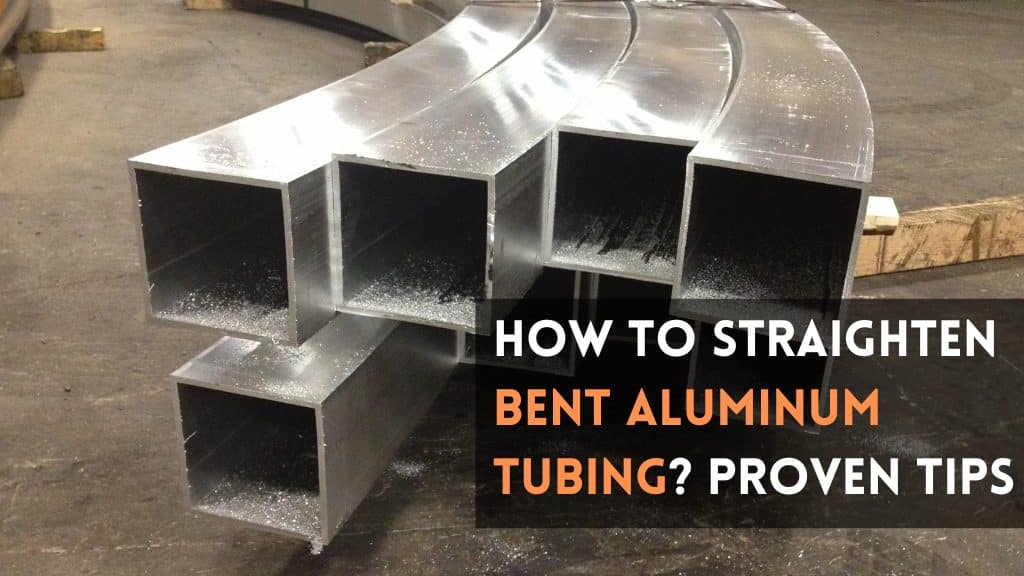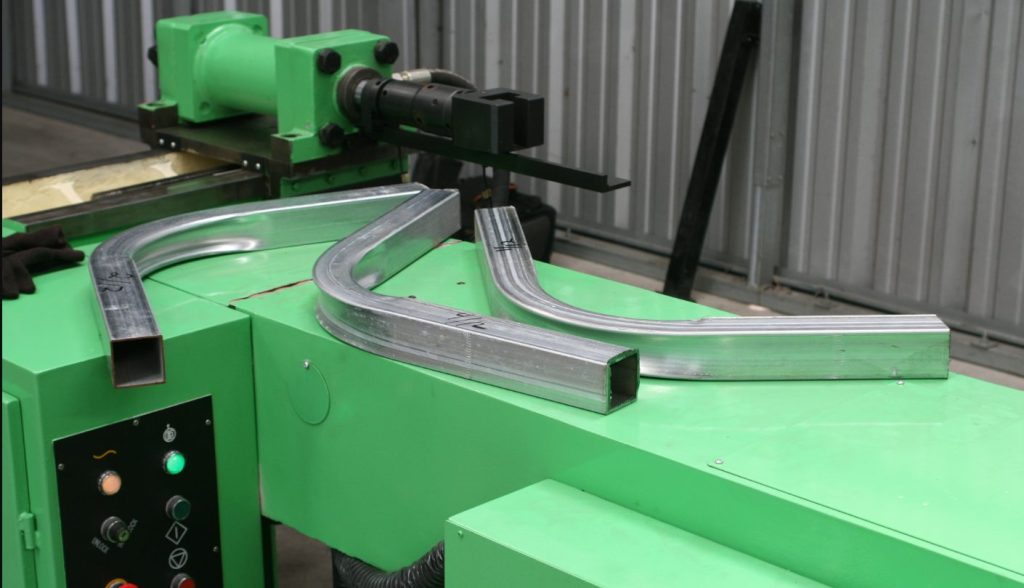Bent aluminum tubing can be a common issue, whether it’s caused by accidents, mishandling, or other factors. Straightening bent aluminum tubing is essential to ensure the structural integrity and functionality of various applications. In this comprehensive guide, we will explore effective methods and techniques to straighten bent aluminum tubing.
We will also address safety precautions and provide valuable tips from experts in the field. So, let’s dive in and learn How to Straighten Bent Aluminum Tubing to its original shape and form!
How to Straighten Bent Aluminum Tubing: Proven Methods and Tips

50
19
80
600
The first step in straightening bent aluminum tubing is to bend the object as straight as possible using your hands. This initial manipulation helps to reduce the severity of the bend and prepares the tubing for further straightening techniques.
Next, lay the aluminum object on a flat, solid surface such as a concrete floor. Using a heat gun, warm the section of the tubing that requires straightening. The heat softens the aluminum, making it more pliable and easier to reshape.
Straightening Process
Once the aluminum tubing is heated, it’s time to begin the straightening process. Apply gradual and gentle pressure to straighten the bent section. Use a combination of hands and appropriate tools, such as pliers, to carefully manipulate the tubing until it aligns with the desired straightness.
Straightening bent aluminum tubing requires a systematic approach to ensure safe and effective results.
Here is a step-by-step guide to help you through Straighten Bent Aluminum Tubing process:
Step 1: Assess the Bend
Examine the bent aluminum tubing carefully to understand the extent and location of the bend. This assessment will help you determine the best approach for straightening the tubing.
Step 2: Prepare the Work Area
Find a suitable workspace with a flat, solid surface such as a concrete floor or workbench. Ensure there is enough space to maneuver the tubing and work comfortably.
Step 3: Apply Heat
Using a heat gun, apply heat to the section of the tubing that needs straightening. Move the heat gun back and forth, evenly distributing the heat along the bent portion. Heating the aluminum tubing softens it, making it more malleable.
Step 4: Use Protective Gear
Before proceeding further, put on appropriate personal protective equipment (PPE) such as safety glasses and gloves. This will protect you from potential hazards during the straightening process.
Step 5: Apply Gradual Pressure
With the heated section of the tubing facing up, start applying gradual pressure to straighten the bend. Begin by using your hands to carefully manipulate the tubing, applying gentle force in the opposite direction of the bend.
Step 6: Utilize Pliers or Pipe Wrenches
If the bend is stubborn and cannot be fully straightened by hand, use pliers or pipe wrenches to apply additional force. Place the tool around the tubing at the bent area and gently twist or pull in the opposite direction of the bend. Exercise caution to avoid applying excessive force that may damage the tubing.
Step 7: Repeat Heating and Straightening
If necessary, repeat Steps 3 to 6, heating the tubing and gradually applying pressure until the desired level of straightness is achieved. Remember to reheat the tubing each time before attempting further adjustments.
Step 8: Check Alignment
Regularly check the alignment of the tubing as you straighten it. Make adjustments as needed to ensure the tubing is straight and aligned with your requirements.
Step 9: Evaluate the Results
Once you have straightened the aluminum tubing to your satisfaction, inspect the tubing for any visible signs of damage or stress. Ensure there are no cracks or deformities that may compromise its structural integrity.
Step 10: Test Functionality
Before using the straightened aluminum tubing, conduct a functionality test to ensure it performs as expected. This may involve fitting the tubing into its intended application or conducting a pressure test if applicable.
Factors to Consider: Thickness and Yield Strength

When straightening aluminum tubing, there are two important factors to consider: the thickness of the tubing and its yield strength. These factors influence the straightening process and the amount of force required to achieve the desired results.
Thickness
- Thicker tubing may require more effort and force to straighten compared to thinner tubing.
- Take into account the thickness of the tubing when determining the suitable techniques and tools to use.
- Be mindful of potential limitations in manipulating thicker tubing due to its rigidity.
Yield Strength
- Yield strength refers to the amount of stress or force the aluminum tubing can withstand before permanent deformation occurs.
- Understand the yield strength of the tubing you are working with to avoid exceeding its limits during the straightening process.
- Applying force beyond the yield strength may result in further damage or failure of the tubing.
Considering the thickness and yield strength of the aluminum tubing is crucial to ensure that you apply the appropriate straightening techniques and avoid any potential risks. By taking these factors into account, you can ensure a successful and safe straightening process.
Remember, it is essential to handle thicker tubing with care and to be mindful of its rigidity. Applying gradual pressure and using appropriate tools such as pliers or pipe wrenches can help overcome the resistance of thicker tubing.
Understanding the yield strength of the aluminum tubing is equally important. This knowledge allows you to gauge the amount of force required to straighten the tubing without exceeding its limits. Exceeding the yield strength can lead to permanent deformation or even fracture of the tubing.
By considering the thickness and yield strength of the aluminum tubing, you can approach the straightening process with confidence and ensure optimal results.
Remember to prioritize safety throughout the entire process and seek professional assistance if needed. With patience and the right techniques, you can successfully straighten bent aluminum tubing and restore its functionality.
Alternative Methods and Tools
In addition to the basic techniques mentioned above, there are alternative methods and tools available for straightening bent aluminum tubing. Let’s explore a few:
a) Tube Rolling or Roll Bending
Tube rolling, also known as roll bending, is a cold forming method that allows for larger bending radiuses to be achieved compared to conventional bending methods. This technique is particularly useful for aluminum sections, enabling precise and efficient bending.
b) Small Diameter Tube Benders
Small diameter tube benders, available in workbench or floor mount styles, offer an excellent option for bending aluminum tubing. These compact benders provide versatility and control, making them ideal for DIY projects and professional applications.
Safety Precautions
While straightening bent aluminum tubing, it is crucial to prioritize safety. Here are some important safety precautions to follow:
- Always wear appropriate personal protective equipment (PPE), including safety glasses and gloves, to protect yourself from potential hazards.
- Work in a well-ventilated area to avoid the inhalation of fumes when using heat or other chemicals.
- Use caution when applying force to the tubing to prevent injury. Apply gradual pressure and avoid sudden movements.
- If the tubing is severely damaged or shows signs of structural weakness, it may be safer to replace it rather than attempting to straighten it.
Conclusion
Straightening bent aluminum tubing requires patience, precision, and the right techniques. By following the steps outlined in this comprehensive guide, you can restore bent aluminum tubing to its original form, ensuring its functionality and performance. Remember to consider the tubing’s thickness and yield strength, and explore alternative methods such as tube rolling or small diameter tube benders for specific applications. Always prioritize safety and exercise caution throughout the straightening process.
FAQs (Frequently Asked Questions)
Can I straighten aluminum tubing without using heat?
While using heat is a common method to soften the aluminum tubing for straightening, it may be possible to straighten certain bends without heat by applying gradual pressure. However, using heat is generally recommended for better results.
Are there any risks involved in straightening bent aluminum tubing?
Yes, there are risks involved in straightening bent aluminum tubing. Applying excessive force or using improper techniques can lead to further damage or even fracture the tubing. It is essential to follow safety precautions and consider the tubing’s thickness and yield strength before attempting to straighten it.
Can I use a pipe wrench to straighten aluminum tubing?
While a pipe wrench can be used to straighten certain types of tubing, it may not be suitable for all situations. Pipe wrenches are generally more effective for smaller diameter tubing. It is important to exercise caution and apply gradual pressure to avoid causing additional damage.
Is it possible to straighten aluminum tubing multiple times?
It is generally not recommended to straighten aluminum tubing multiple times as repeated bending and straightening can weaken the metal. If the tubing has been straightened before and requires additional modifications, it may be safer and more effective to replace it with new tubing.
Can professionals help with straightening bent aluminum tubing?
Yes, if you’re uncertain or uncomfortable straightening aluminum tubing yourself, it’s advisable to seek assistance from professionals. They have the expertise and specialized tools to ensure the tubing is straightened correctly and safely.